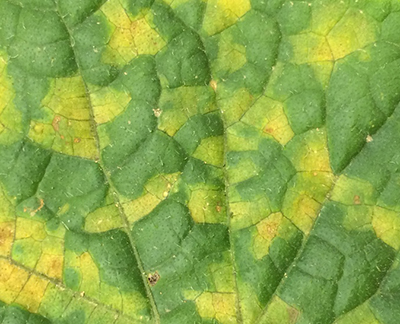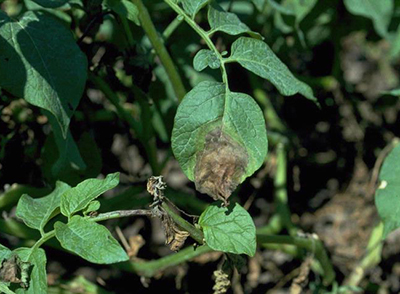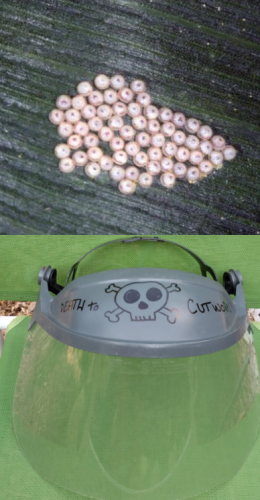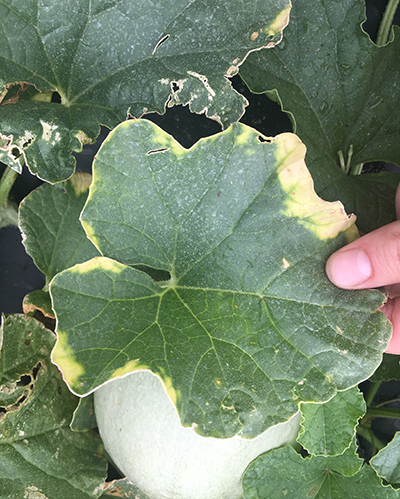Southeast Michigan vegetable update – July 12, 2017
Disease incidence is increasing and the next wave of insect pests is on the horizon.
Weather
Rain over the last few days has fields quite wet. There will likely be more rain and storms rolling through the region over the next couple of days, which could bring a couple more inches of rain.
Note that this rain, heat and humidity provide perfect conditions for a wide range of disease, both foliar (e.g., downy mildew and late blight) to soil-borne (e.g., phytopthera). The rain can throw off spray schedules, but it also makes preventative fungicide applications important.
The table below presents rainfall (in inches) for the Michigan State University Enviroweather stations in southeast Michigan with the amount of change from last week reported. Growing degree-days (GDD) starting March 1 are calculated using the Baskerville-Emin Method.
|
Rainfall and GDD totals as of July 12 |
|||
|---|---|---|---|
|
Enviroweather Station |
GGD base 50 |
5-year GDD average base 50 |
Rainfall since April 1 (inches) |
|
1156 (+140) |
1186.9 |
9.01 (+1.19) |
|
|
1379 (+150) |
NA |
11.11 (+0.88) |
|
|
1230 (+141) |
1324.1 |
12.21 (+2.09) |
|
Crops
Cucumber harvest is ongoing, with good quality reported from field and greenhouse plantings. Apply protective fungicides and look for downy mildew. The sample that was confirmed as downy mildew in Monroe County was well-developed, suggesting the disease is well-established in the county and likely to be present across southeast Michigan. MSU Extension plant pathologist Mary Hausbeck’s recommended downy mildew fungicides this year are Orondis Opti, Ranman 4SC, Gavel 75DF, Zampro 4.4SC and Zing! SC. For suggested tank-mixes and more information on downy mildew, see “Downy mildew confirmed on cucumber in Michigan and Ohio.”
If you suspect downy mildew is in your fields, please contact me at 517-264-5309 to arrange for sample pickup; even if the disease has already been confirmed in your county, the Hausbeck Lab is studying the population of downy mildew in Michigan and sample submission can aid in better understanding the disease.

Downy mildew produces characteristic yellow, angular lesions on the upper side of cucumber leafs. Photo by Rebecca A. Melanson, Mississippi State University Extension, Bugwood.org.
Pepper plants have taken off in the last two weeks, and peppers are good size. Harvest will begin in the next week or two. Second generation of European corn borer is likely to emerge in the next couple of days in our area—I am trapping for this pest in Lenawee, Monroe and Washtenaw counties and will track the emergence in next week’s report.
Potato growers should note that late blight has been found in Michigan. With the recent wet weather and high incidence of volunteer potato survival, keep an eye out for this disease. If you have any suspected plants on your farm, contact me at 517-264-5309 and I can arrange for it to be taken to campus and tested for late blight quickly and at a low cost. For detailed information on spotting this disease as well as management, see “Late blight found in potato in Michigan’s St. Joseph County.”

Late blight produces dark areas on potatoes leafs and velvety growth. These symptoms are the easiest to spot in the morning before the dew begins to dry. Photo by Howard F. Schwartz, Colorado State University, Bugwood.org.
MSU Diagnostic Services has been seeing more samples coming in with black leg, and incidences will only increase with current weather conditions. For more information, see “Aerial stem rot, blackleg and tuber soft disease reported in Michigan potato fields.”
Sweet corn harvest from early planted fields will begin this week. Growers are reporting low numbers of corn earworm being trapped over the last week. As your corn reaches maturity, treatments for corn earworm are not necessary when 90 percent of the silks in a field have browned. Trapping efforts by local growers and Ohio State University Extension have seen an increase in the number of western bean cutworm being caught in traps over the last week, which is typical as the peak populations of this pest are usually seen mid-July.
Corn earworm is a newer corn pest in Michigan, so thresholds do not yet exist, but is likely adequately controlled by spray programs for other ear pests. Unlike other caterpillar pests of sweet corn, scouting for the eggs of this pest is easy as the eggs are quarter-sized and laid on the upper surface of the leaf. MSU Extension field crop entomologist Christina DiFonzo recommends getting a plastic face mask, which can allow you to quickly scout a field.
Moths are most attracted to fields that are pre-tassel, but treatment for corn earworm is key in field where eggs or larvae, and ears, are present. This pest can cause damage to Bt sweet corn hybrids, so even these may need protection.
Second generation of European corn borer is likely to emerge in the next couple of days.

Top: Western bean cutworm eggs are laid in quarter-sized masses on the leaf surface. Photo by Frank Peairs, Colorado State University, Bugwood.org. Bottom: A face mask makes it easy to walk through a field and spot eggs masses. Photo by Christina DiFonzo, MSU.
Tomato growers should be aware that late blight has been confirmed in Michigan potato and Ontario tomatoes. For prevention of this disease, Bravo and Quadris, which are often used for common foliar fungal disease like septoria, are effective if being applied in weekly intervals. Once the spray interval starts to get stretched out to 14 days, coverage may not be adequate if late blight has been confirmed in adjacent counties.
Once late blight is occurring locally, shorten the interval to seven days or add more late blight specific products into the mix. Make sure coverage is even throughout the field, even near obstacles like power poles. This disease can be prevented as fungicides for other problems provide late blight coverage.
For organic growers, Badge X2 is a product that can be used, although it has a longer re-entry interval. While biological products are available, the best option is copper products in combination with keeping up with staking and weeding to promote air flow.
Processing tomatoes are coming along, though some fields will likely see yield decreases because the very cold (for those planted in early May) or very hot (for those planted in early June) weather that occurred during planting.
Market tomatoes look good overall, with fruit approximately 3-4 inches of diameter. I am monitoring for brown marmorated stink bugs in Lenawee and Washtenaw counties, and have caught none in either county.
Muskmelon and watermelon growers should be monitoring for downy mildew and applying preventative fungicides. See the cucumber section for more information. Muskmelon and watermelon are sizing up well. I’ve seen some muskmelons with yellowing on the leaf edge, which is impacted by varietal and nutrient factors. This condition is more common in some melon varieties, and is thought to be caused by excess salt in the soil. It looks alarming, but typically does not impact yield.

The yellowing on the edge of this melon leaf is likely caused by salt levels. Photo by Marissa Schuh, MSU Extension.
The wet weather is likely to bring in the onset of more diseases in vine crops. MSU Diagnostic Services is seeing a lot of phytophthora in winter and summer squash, as well as pumpkin. If you are in a field with a history of this disease, the recent turns of weather warrant protective fungicide application. Orondis has been found to be very effective in controlling phytophthora, but rotate products in order to prevent resistance forming. Timing is also key—small fruit should have some kind of protectant, as they are the most vulnerable. In winter squash, the squash gain some level of phytophthora resistance at approximately 21 days of age, so protection before this mark is key. It is also the time of year when powdery mildew starts to appear.
Squash vine borer adults are out. I caught a second moth in Washtenaw County this week, so keep an eye for wilted vines and frass as the crown of the plant. The Lenawee County trap has caught no moths to date.
As winter squash and pumpkins begin to flower, time sprays later in the day (think dusk or after dinner) to protect bees. Bees are most active mid-morning, so this is a good time to look for bees in your field if you are trying to monitor their activity.
Contact me at any time at 517-264-5309 or schuhmar@msu.edu for pest or disease sampling. I make updates regularly on Twitter at @SoutheastMIVeg.
Meetings
The Midwest Mechanical Weed Control Field Day is Sept. 26 at the MSU Horticulture Farm. This meeting will feature mechanical weeders from the U.S. and Europe, as well as the experiences of farmers who use these tools. For more information and registration, see “Midwest Mechanical Weed Control Field Day.”
Hotels are filling up for the Great Lakes Fruit and Vegetable EXPO, Dec. 5-7 in Grand Rapids, Michigan. The combination of grower-focused, research-backed presentations and an amazing exhibit hall make it a can’t-miss event.



 Print
Print Email
Email

